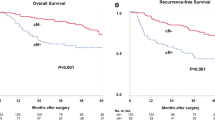Abstract
Purpose
A multimodality approach using concurrent chemoradiotherapy (CRT) followed by esophagectomy has been the standard treatment in patients with locally advanced esophageal squamous cell carcinoma (ESCC). Computed tomography (CT) is widely utilized to evaluate esophageal cancer before and after CRT. This study evaluated the utility of pretreatment maximal esophageal wall thickness on CT scans to predict treatment outcomes after CRT in patients with locally advanced ESCC.
Methods
Eighty-one patients with T3 locally advanced ESCC, whom were treated completely with CRT with and without surgery, and had available CT scans before and after CRT at a university hospital between 2005 and 2015, were retrospectively reviewed.
Result
Twenty patients (24.7%) had esophagectomy after neoadjuvant CRT and sixty-one patients (75.3%) had definitive CRT. The maximal esophageal wall thicknesses were measured retrospectively and correlated with the response and survival after treatment. A total of 40% of neoadjuvant CRT patients achieved a pCR. There was a significant difference in pretreatment maximal esophageal wall thickness between the pCR and non-pCR groups (mean 11.9 ± 5.3 mm versus 16.9 ± 3 mm; p = 0.01). Pretreatment maximal esophageal wall thickness < 10 mm was significantly related to better overall survival than ≥ 10 mm (median survival 79 months versus 15 months; HR 3.21, 95%CI 1.14–9; p = 0.02). The neoadjuvant CRT group had significantly better survival than the definitive CRT group (median survival 51 months versus 14.5 months; HR 0.46; 95%CI 0.25–0.85; p = 0.01).
Conclusion
In our study, pretreatment esophageal wall thickness of T3 locally advanced ESCC is a useful indicator for predicting survival and pCR after treatment.


Similar content being viewed by others
References
Ferlay J, Soerjomataram I, Dikshit R, et al. Cancer incidence and mortality worldwide: sources, methods and major patterns in GLOBOCAN 2012. Int J Cancer. 2015;136:E359–86.
NCCN clinical practice guidelines in oncology; esophageal and esophagogastric junction cancers. Version 1.2019 available from www.nccn.org. Accessed May 1, 2019. National Comprehensive Cancer Network, Inc.
Kuwano H, Nishimura Y, Oyama T, et al. Guidelines for diagnosis and treatment of carcinoma of the esophagus April 2012 edited by the Japan Esophageal Society. Esophagus. 2015;12:1–30.
Martin-Richard M, Díaz Beveridge R, Arrazubi V, Alsina M, Galan Guzmán M, Custodio AB, et al. SEOM Clinical Guideline for the diagnosis and treatment of esophageal cancer (2016). Clin Transl Oncol. 2016;18:1179–86.
Shapiro J, van Lanschot JJB, Hulshof MCCM, et al. CROSS study group. Neoadjuvant chemoradiotherapy plus surgery versus surgery alone for oesophageal or junctional cancer (CROSS): long-term results of a randomised controlled trial. Lancet Oncol. 2015;16:1090–8.
Herskovic A, Russell W, Liptay M, et al. Esophageal carcinoma advances in treatment results for locally advanced disease: review. Ann Oncol. 2012;23:1095–103.
van Hagen P, Hulshof MC, van Lanschot JJ, Steyerberg EW, van Berge Henegouwen M, Wijnhoven BP, et al. Preoperative chemoradiotherapy for esophageal or junctional cancer. N Engl J Med. 2012;366:2074–84.
Klevebro F, Alexandersson von Döbeln G, Wang N, Johnsen G, et al. A randomized clinical trial of neoadjuvant chemotherapy versus neoadjuvant chemoradiotherapy for cancer of the oesophagus or gastro-oesophageal junction. Ann Oncol. 2016;27:660–7.
Berger AC, Farma J, Scott WJ, Freedman G, Weiner L, Cheng JD, et al. Complete response to neoadjuvant chemoradiotherapy in esophageal carcinoma is associated with significantly improved survival. J Clin Oncol. 2005;23:4330–7.
Donohoe CL, Reynolds JV. Neoadjuvant treatment of locally advanced esophageal and junctional cancer: the evidence-base, current key questions and clinical trials. J Thorac Dis. 2017;9:S697–704.
Stahl M, Stuschke M, Lehmann N, et al. Chemoradiation with and without surgery in patients with locally advanced squamous cell carcinoma of the esophagus. J Clin Oncol. 2005;23:2310–7.
Bedenne L, Michel P, Bouche O, et al. Chemoradiation followed by surgery compared with chemoradiation alone in squamous cancer of the esophagus: FFCD 9102. J Clin Oncol. 2007;25:1160–8.
Li SH, Rau KM, Lu HI, et al. Pre-treatment maximal oesophageal wall thickness is independently associated with response to chemoradiotherapy in patients with T3–4 oesophageal squamous cell carcinoma. Eur J Cardiothorac Surg. 2012;42:958–64.
Rice TW. Clinical staging of esophageal carcinoma: CT, EUS, and PET. Chest Surg Clin N Am. 2000;10:471–85.
Edge SB, Byrd DR, Compton CC, et al., editors. AJCC cancer Staging Manual. 7th edn. New York: Springer; 2009. p. 103–15.
Rizk NP, Seshan VE, Bains MS, et al. Prognostic factors after combined modality treatment of squamous cell carcinoma of the esophagus. J Thorac Oncol. 2007;2:1117–23.
Nomura M, Oze I, Kodaira T, Abe T, Komori A, Narita Y, et al. Comparison between surgery and definitive chemoradiotherapy for patients with resectable esophageal squamous cell carcinoma: a propensity score analysis. Int J Clin Oncol. 2016;21:890–8.
Sathornviriyapong S, Matsuda A, Miyashita M, et al. Impact of neoadjuvant chemoradiation on short-term outcomes for esophageal squamous cell carcinoma patients: a meta-analysis. Ann Surg Oncol. 2016;23:3632–40.
Kumbasar B. Carcinoma of esophagus: radiologic diagnosis and staging. Eur J Radiol. 2002;42:170–80.
Kim TJ, Kim HY, Lee KW, et al. Multimodality assessment of esophageal cancer: preoperative staging and monitoring of response to therapy. Radiographics. 2009;29:403–21.
Acknowledgments
We would like to thank David Patterson of the Faculty of Medicine Office of International Relations for his assistance with the English in the manuscript, and Jureerat Saengthong of the Research Unit for helping with statistical analysis in the study.
Funding
This study was supported by the Faculty of Medicine, Prince of Songkla University.
Author information
Authors and Affiliations
Corresponding author
Ethics declarations
This retrospective study was approved by Institutional Ethical Commission Review Board.
Conflict of interests
The author(s) declare no potential conflicts of interest.
Additional information
Publisher’s Note
Springer Nature remains neutral with regard to jurisdictional claims in published maps and institutional affiliations.
Rights and permissions
About this article
Cite this article
Wongwaiyut, K., Ruangsin, S., Laohawiriyakamol, S. et al. Pretreatment Esophageal Wall Thickness Associated with Response to Chemoradiotherapy in Locally Advanced Esophageal Cancer. J Gastrointest Canc 51, 947–951 (2020). https://doi.org/10.1007/s12029-019-00337-3
Published:
Issue Date:
DOI: https://doi.org/10.1007/s12029-019-00337-3




